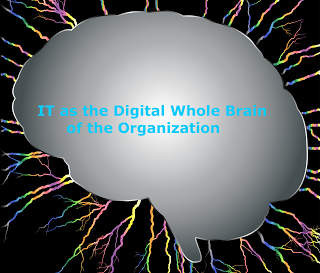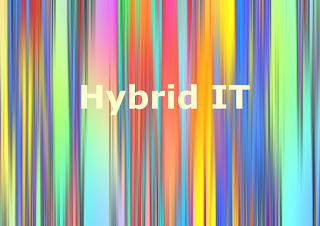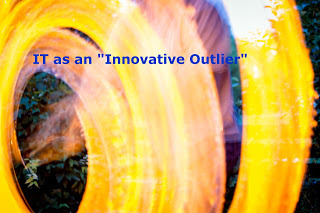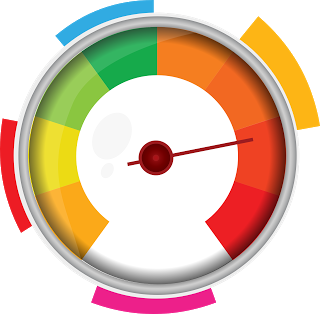Pearl Zhu's Blog, page 1280
November 7, 2016
The CIO’s Digital Agenda: Close the Gaps in IT Digital Transformation Nov. 2016
 With the increasing speed of changes, many organizations are inundated with tactical tasks and daily operational duties, they don’t spend enough time on scrutinizing the long term strategy and identify disastrous blind spots in order to make a smooth business transformation. Indeed, there are both blind spots in strategy formulation and execution. So how to identify and close those blind spots in order to accelerate digital transformation. Close the Talent Gaps in IT Digital Transformation IT Skills Gap? According to industry surveys, IT skills gap is a significant challenge facing IT leaders today, what are exactly the skills gaps and what are the resulting symptoms? For example, business have job openings, but cannot find people with the right skill set; or the talent people they current have do not have the right competencies to adapt to the changes; or their business partners do not understand IT. Sometimes, the gaps people usually pick are not root causes, they are symptoms of specific best practices not being used. So what are the organizational best practices/ways that have been deployed to close the gap?.?
With the increasing speed of changes, many organizations are inundated with tactical tasks and daily operational duties, they don’t spend enough time on scrutinizing the long term strategy and identify disastrous blind spots in order to make a smooth business transformation. Indeed, there are both blind spots in strategy formulation and execution. So how to identify and close those blind spots in order to accelerate digital transformation. Close the Talent Gaps in IT Digital Transformation IT Skills Gap? According to industry surveys, IT skills gap is a significant challenge facing IT leaders today, what are exactly the skills gaps and what are the resulting symptoms? For example, business have job openings, but cannot find people with the right skill set; or the talent people they current have do not have the right competencies to adapt to the changes; or their business partners do not understand IT. Sometimes, the gaps people usually pick are not root causes, they are symptoms of specific best practices not being used. So what are the organizational best practices/ways that have been deployed to close the gap?.?How to Close the Gaps in IT Talent Management People are always the most invaluable asset to any organization, and having the right person in the right position at the right time is always one of the biggest challenges facing any business. This is particularly true for IT, due to the changing nature of technology and abundance of information. Some fresh mindsets, new skills, or integral digital capabilities are needed every day because we live in a time of rapidly changing digital dynamic. However, people are often the weakest link in strategy execution as well, so how to identify and close the gaps in IT talent management more specifically?Is IT skills Gap Fact or Fiction? There’s always a debate regarding IT talent supply and demand, does IT skills gap really exist? Or is it due to any management issues such as misunderstanding or miscommunication upon talent value chain? What is the root cause and how to solve the problem?
Digital Talent Gap Minding in Running a Digital Fit IT? Human capital is always the most valuable asset in any business, especially now the rate of change is accelerated, and knowledge life cycle is significantly shortened. The talent gap is the reality, not a fiction, this is particularly true for IT talent management due to the exponential growth of information and change nature of technology. Organizations now have to make more tough choices to compete for the future, not just live in the past; to balance the short term talent demand and long-term strategic talent requirement. More specifically, which approach should IT take to fill the mindset/capability/skill gaps and also innovate talent management to capture the emergent digital trends, ride above the learning curve, and build an alternative digital talent pipeline?
How to Fill Skills Gaps via Proper Trainings? We live in a time of rapidly changing technology and business dynamic, the growth minds, the new skills, or digital capabilities are needed every day. From talent management perspective, more specifically, how do you identify skill gap issues (some are real, some are “artificial,”) and how to fill competency gaps via proper training?
 How to Mind Gaps and Measure Human Capital Effectively? People are always the most invaluable asset to the organization but often turn to be the weakest link in strategy execution. Unlike the other tangible value of business assets which are more easily measured in a quantitative way. The true value of people, especially today’s high professional knowledge workforces include many tangible and intangible factors because people are not just the cost or the resource to be managed, but the capital to be invested in and their potential if unleashed can bring the quantum leap in the business growth. So what are the premium approach and methodology to measure human asset & capital? What KPIs would you recommend to determine the value an employee adds to their department and ultimately to their organization, and how would you implement it?
How to Mind Gaps and Measure Human Capital Effectively? People are always the most invaluable asset to the organization but often turn to be the weakest link in strategy execution. Unlike the other tangible value of business assets which are more easily measured in a quantitative way. The true value of people, especially today’s high professional knowledge workforces include many tangible and intangible factors because people are not just the cost or the resource to be managed, but the capital to be invested in and their potential if unleashed can bring the quantum leap in the business growth. So what are the premium approach and methodology to measure human asset & capital? What KPIs would you recommend to determine the value an employee adds to their department and ultimately to their organization, and how would you implement it?The “Future of CIO” Blog has reached 1.5+million page views with about #3200+ blog posting in 59+ different categories of leadership, management, strategy, digitalization, change/talent, etc. blog posting. The content richness is not for its own sake, but to convey the vision and share the wisdom, to inspire critical thinking and spur healthy debates. Blogging is not about writing, but about thinking and innovating the new ideas; it’s not just about WHAT to say, but about WHY to say, and HOW to say it. It reflects the color and shade of your thought patterns, and it indicates the peaks and curves of your thinking waves. Unlike pure entertainment, quality and professional content takes time for digesting, contemplation and engaging, and therefore, it takes the time to attract the "hungry minds" and the "deep souls." It’s the journey to amplify diverse voices and deepen digital footprints, and it's the way to harness your innovative spirit.Follow us at: @Pearl_Zhu
Published on November 07, 2016 22:55
"Digitizing Boardroom" Book Tuning: The Digital Board’s Journey from Good to Great
 Due to the complexity, uncertainty, ambiguity and volatility of the digital age, the directorship in any organization must have the ability to inspire, guide, and motivate top management team toward accomplishing shared visions and goal. The level of Board accomplishment may vary but the essential competencies will remain the same, BoDs need to be insightful, influential, and highly effective, and the board as a whole needs to be able to create the holistic view, and transform from compliance-centric to performance driven, this also implies that Boards of the future will need to work much more closely and collaboratively to take the digital journey from good to great.
Due to the complexity, uncertainty, ambiguity and volatility of the digital age, the directorship in any organization must have the ability to inspire, guide, and motivate top management team toward accomplishing shared visions and goal. The level of Board accomplishment may vary but the essential competencies will remain the same, BoDs need to be insightful, influential, and highly effective, and the board as a whole needs to be able to create the holistic view, and transform from compliance-centric to performance driven, this also implies that Boards of the future will need to work much more closely and collaboratively to take the digital journey from good to great.Pinpoint the blindspots of the strategy: The contemporary board play crucial role in overseeing business strategy. The strategy is definitely a different beast nowadays, with increasing speed of changes, many organizations are inundated with tactical tasks and daily operational duties, they don’t spend enough time on scrutinizing the long term strategy and identify disastrous blind spots in order to make a smooth business transformation. Strategy blind spot created by the lack of future-driven mindset, that means the management probably wouldn't know where is the weakest link in the business and how to invest in new capabilities for their business, even if the organization thought there was any value justification for making the investment. The traditional strategy is the view via considerably narrow frames with static timelines, but digital strategy view is broader to oversee the business ecosystem and has to embrace the emergent digital dynamic with continuous disruptions. The BoDs as the business critic can provide excellent feedback which gives the top management accurate information to improve; great questions to self-aware; and keen insight to gain the in-depth understanding of the digital ecosystem. Or to put simply, there are both blind spots in strategy formulation and execution. BoDs need to present strategic wisdom to pinpoint pitfalls in strategy management and keep track of strategy-execution continuum. In a world of well-defined problems, directors are required to exercise leadership influence over volatility, manage uncertainty, simplify complexity, and resolve ambiguity in the 21st-century digital environment.
Minding the cognitive gaps for setting the top leadership tone and expand innovation lens: Generating a high-performing Board is a question of appointing the right persons to Boards which implies” inclusiversity.” It's the diversity both from a cognitive difference or functional perspective. Boards need to have qualified candidates who bring cognitive diversity to a Boardroom. Anyone who is selected to sit on a corporate board should be fully qualified to bring the fresh insight to mind the cognitive gap. Some of these credentials are proven experience in executive leadership, entrepreneurship, strategy development, technological vision, risk and crisis management, global empathy, international experiences, and some degree of financial literacy. The board needs to extend its innovation lens via cognitive difference. An insightful board built on the diversity of thought more often does not necessarily come from the diverse physical identity; but from one’s thought process, cognitive difference, learning habit, recombinant capability, diverse experience or skill sets, etc. Nowadays we live in complex digital systems, it takes a 'different'' thinking, uses the right tools and leverages effective process in GRC practices. Diversification is a component and in some cases a very good initiation of value creation. If it builds on and across supports other assets, people start to think, understand, learn and work together leading to better decisions and better performance, and thus transform the business from good to great!
 IT savvy: Information is the lifeblood and one of the most invaluable assets in digital businesses today, technology is the disruptive force in digital transformation.Given how applying IT is becoming so intrinsically important to so many different enterprises, digital BoDs need to become information friendly and technology-savvy. The board is neither the programmer nor the implementer, but they should gain the strategic insight about IT. The foremost thing for BoD is to realize that IT is strategic; and as such, it should be a distinct part of the business strategy telling how to maintain compliant and secure and how to enable business growth. Digital transformation represents a break with the past, with a high level of impact and complexity. IT is a key enabler of future capability and a critical aspect of continuing business activities in organizations. Therefore, an IT-friendly board has to ensure management and governance are an interdependent and complementary discipline that are both enabled by high mature digital IT, and a technology savvy Board will welcome IT leaders to share insight at the big table and empower IT to drive change and digital transformation.
IT savvy: Information is the lifeblood and one of the most invaluable assets in digital businesses today, technology is the disruptive force in digital transformation.Given how applying IT is becoming so intrinsically important to so many different enterprises, digital BoDs need to become information friendly and technology-savvy. The board is neither the programmer nor the implementer, but they should gain the strategic insight about IT. The foremost thing for BoD is to realize that IT is strategic; and as such, it should be a distinct part of the business strategy telling how to maintain compliant and secure and how to enable business growth. Digital transformation represents a break with the past, with a high level of impact and complexity. IT is a key enabler of future capability and a critical aspect of continuing business activities in organizations. Therefore, an IT-friendly board has to ensure management and governance are an interdependent and complementary discipline that are both enabled by high mature digital IT, and a technology savvy Board will welcome IT leaders to share insight at the big table and empower IT to drive change and digital transformation.Good boards advise great boards inspire; good boards take compliance lens to ensure nothing is broken; great boards set the digital leadership tone to break outdated rules, and build digital principles; good boards have peer relationships, but great boards present creative tension, you know it when you see it. Great boards are heterogeneous, inquisitive, effective, innovative and influential. All of these require thinking, requiring asking questions, to sharpen “directorship” for getting digital ready.
Follow us at: @Pearl_Zhu
Published on November 07, 2016 22:51
The New Book “IT Innovation” Introduction Chapter 4 Fine-Tune IT as the Digital “Whole Brain” of the Organization
 IT is the steward to manage business information, it is like the business’s nervous system to ensure the right information getting to the right people at the right time to make right decisions. IT also helps the business to optimize processes, cost and capture the business insight for growth opportunities. But is digital IT more like the LEFT brain, RiGHT brain, or the WHOLE brain of the organization?
IT is the steward to manage business information, it is like the business’s nervous system to ensure the right information getting to the right people at the right time to make right decisions. IT also helps the business to optimize processes, cost and capture the business insight for growth opportunities. But is digital IT more like the LEFT brain, RiGHT brain, or the WHOLE brain of the organization?Running “I” information driven IT to improve the overall business’s “digital IQ”: Information Management means that the business has information, that information has the right quality, that the information is used properly. Information is the foundation of creating business insight, insights perceive the new business opportunities and risks. IT stands out as a value-added function by managing information effectively and efficiently. It can abstract business and customer insight from abundant information, and bring to the table tailored solutions that meet customers’ needs, while reducing the cost to market, without sacrifice of strategic goals. Hence, be rational as the left side of the brain, works on improving process efficiency and optimizing operational cost, and be creative as the right side of the brain; Digital is the age of options and innovation, it provides the opportunity to think the new way to do things. So it forces IT leaders to get really creative on how they implement changes, to ensure IT is strategically positioned to be ahead of where the business is moving next. Regardless of sectors, IT needs to become an innovation engine and transform from a mere enabler to the digital whole brain of the business.
Setting key principles to ensure Information Management effectiveness in order to run highly cognitive digital IT: Information management entails organizing, retrieving, acquiring, securing, maintaining, updating, distributing, sharing, publishing and achieving information. The key principles of information management are to ensure that information management activities are effective and successful via delivering tangible and visible benefits and providing a seamless user experience. IT needs to engage with the business units to find out how the department is perceived, what the pain points are and identify opportunities for developing new services/solutions, or improving/optimizing current ones. The value of information technology must be qualitative, measurable, and defined uniquely by an organization. A digital IT organization with highly cognitive connectivity plays a crucial role in building a high-responsive, and high mature digital business.
 Information Management as a differentiator between digital master and digital laggard: IT has to get more involved in the business as solutioneering. CIOs that are successfully showing how much money IT can save and how much it can make are the ones that get true buy-in and commitment from the boards. It is important to identify how information is associated with the valued tangibles of businesses, products, and resources. IT has to step into businesses with knowledge and confidence as a strategic business partner, and IT being part of decision-making is the only way to bridge the gap between business and IT, and the industrial age and the digital era. Therefore, Information Management is the key differentiator between digital leaders and laggards, high-performing organizations, and mediocre companies.
Information Management as a differentiator between digital master and digital laggard: IT has to get more involved in the business as solutioneering. CIOs that are successfully showing how much money IT can save and how much it can make are the ones that get true buy-in and commitment from the boards. It is important to identify how information is associated with the valued tangibles of businesses, products, and resources. IT has to step into businesses with knowledge and confidence as a strategic business partner, and IT being part of decision-making is the only way to bridge the gap between business and IT, and the industrial age and the digital era. Therefore, Information Management is the key differentiator between digital leaders and laggards, high-performing organizations, and mediocre companies.Running IT as the “whole brain” of the business with both high digital IQ and EQ can proactively build all different management capabilities and play a different role to the situation at hand. Technology is the disruptive force behind the digital transformation, information is a gold mine. And information can bring businesses the transformational value and huge wealth to any organization if it is well managed and wisely used. IT can stand out as a value-added organization by managing information effectively and efficiently, that will allow IT to shine in both roles -an enabler and driver.
Follow us at: @Pearl_Zhu
Published on November 07, 2016 22:41
November 6, 2016
The Monthly “Dot Connections” Mind vs. Mind Nov., 2016
Diagnose the problems and lead changes at the mindset level.
 The effects of an increasingly digitalized world are now reaching into every corner of businesses and every aspect of organizations. Diagnose the problems and lead changes at the mindset level. The right mind is the foundation with which to build competitive capabilities and drive the right attitude.
The effects of an increasingly digitalized world are now reaching into every corner of businesses and every aspect of organizations. Diagnose the problems and lead changes at the mindset level. The right mind is the foundation with which to build competitive capabilities and drive the right attitude.
Mind vs. Mind Dot Connection Nov. 2016
Critical Thinking vs. Creative Thinking in Workplace: Both critical thinking and creative thinking are vital in a workplace. These skills hand in hand help drive the growth of an organization and its employees as well as enable effectiveness (doing the right things or framing the right questions) efficiency (doing things right) and agility (ability to adapt to the changes) in solving problems and making decisions?Problem vs. Opportunity Mindset? We are all familiar with such philosophical reasoning: Every risk (problem) has an opportunity in it, and every opportunity has a risk (problem) in it. Isn't opportunities and problems the same thing only with a perceptive change? Doesn't it come down to how we view the situation - at the time it could be a problem or it could be an opportunity? Or to put simply, are they sort of mindset?Holistic Thinking vs. Mechanistic Thinking At the industrial age, the mechanical mind is a “mainstream” thinking process to solve the problems via reductionism, it may work well because the business environment does not change so dramatically, and the organization or the whole world were running in a silo. However, digital means flow, hyper-connectivity and interdependence, the holistic thinking which requires interdisciplinary knowledge and systematic approach is on demand to deal with today’s over-complex business dynamic. What is the perceived difference between holistic and mechanistic thinking? What are the characteristics of situations/problems in which we should adopt holistic thinking ( vs. mechanistic thinking)? When is the trade-off more beneficial in adopting holistic thinking versus mechanistic thinking?.Optimistic vs. Pessimistic Mind An optimistic mind sees the sunny side of the things and the world; a pessimistic mind sees the dark side of the things and the world; there’s nothing absolutely right or wrong with both types of minds, but it is optimistic mind pushes the world moving forward and makes the life progressive. Intuitive vs. Deliberate Thought: Perhaps the mind is one of the most complex things in the world; the mind is the interface between body and consciousness. It can be very active if we care for it. We worry about our body, leaving our mind and consciousness in our actions. In jumping the marvels of how we came to be at this point where it can be described in mapping the brain, we really have the need to know the foundation of thought itself. And how to shift from intuitive to deliberate thought.The “Future of CIO” Blog has reached 1.6 million page views with about #3200th blog posting in 59+ different categories of leadership, management, strategy, digitalization, change/talent, etc. The content richness is not for its own sake, but to convey the vision and share the wisdom. Blogging is not about writing, but about thinking and innovating the new ideas; it’s not just about WHAT to say, but about WHY to say, and HOW to say it. It reflects the color and shade of your thought patterns, and it indicates the peaks and curves of your thinking waves. Unlike pure entertainment, quality and professional content takes time for digesting, contemplation and engaging, and therefore, it takes the time to attract the "hungry minds" and the "deep souls." It’s the journey to amplify diverse voices and deepen digital footprints, and it's the way to harness your innovative spirit.
Intuitive vs. Deliberate Thought: Perhaps the mind is one of the most complex things in the world; the mind is the interface between body and consciousness. It can be very active if we care for it. We worry about our body, leaving our mind and consciousness in our actions. In jumping the marvels of how we came to be at this point where it can be described in mapping the brain, we really have the need to know the foundation of thought itself. And how to shift from intuitive to deliberate thought.The “Future of CIO” Blog has reached 1.6 million page views with about #3200th blog posting in 59+ different categories of leadership, management, strategy, digitalization, change/talent, etc. The content richness is not for its own sake, but to convey the vision and share the wisdom. Blogging is not about writing, but about thinking and innovating the new ideas; it’s not just about WHAT to say, but about WHY to say, and HOW to say it. It reflects the color and shade of your thought patterns, and it indicates the peaks and curves of your thinking waves. Unlike pure entertainment, quality and professional content takes time for digesting, contemplation and engaging, and therefore, it takes the time to attract the "hungry minds" and the "deep souls." It’s the journey to amplify diverse voices and deepen digital footprints, and it's the way to harness your innovative spirit.
Follow us at: @Pearl_Zhu
 The effects of an increasingly digitalized world are now reaching into every corner of businesses and every aspect of organizations. Diagnose the problems and lead changes at the mindset level. The right mind is the foundation with which to build competitive capabilities and drive the right attitude.
The effects of an increasingly digitalized world are now reaching into every corner of businesses and every aspect of organizations. Diagnose the problems and lead changes at the mindset level. The right mind is the foundation with which to build competitive capabilities and drive the right attitude. Mind vs. Mind Dot Connection Nov. 2016
Critical Thinking vs. Creative Thinking in Workplace: Both critical thinking and creative thinking are vital in a workplace. These skills hand in hand help drive the growth of an organization and its employees as well as enable effectiveness (doing the right things or framing the right questions) efficiency (doing things right) and agility (ability to adapt to the changes) in solving problems and making decisions?Problem vs. Opportunity Mindset? We are all familiar with such philosophical reasoning: Every risk (problem) has an opportunity in it, and every opportunity has a risk (problem) in it. Isn't opportunities and problems the same thing only with a perceptive change? Doesn't it come down to how we view the situation - at the time it could be a problem or it could be an opportunity? Or to put simply, are they sort of mindset?Holistic Thinking vs. Mechanistic Thinking At the industrial age, the mechanical mind is a “mainstream” thinking process to solve the problems via reductionism, it may work well because the business environment does not change so dramatically, and the organization or the whole world were running in a silo. However, digital means flow, hyper-connectivity and interdependence, the holistic thinking which requires interdisciplinary knowledge and systematic approach is on demand to deal with today’s over-complex business dynamic. What is the perceived difference between holistic and mechanistic thinking? What are the characteristics of situations/problems in which we should adopt holistic thinking ( vs. mechanistic thinking)? When is the trade-off more beneficial in adopting holistic thinking versus mechanistic thinking?.Optimistic vs. Pessimistic Mind An optimistic mind sees the sunny side of the things and the world; a pessimistic mind sees the dark side of the things and the world; there’s nothing absolutely right or wrong with both types of minds, but it is optimistic mind pushes the world moving forward and makes the life progressive.
 Intuitive vs. Deliberate Thought: Perhaps the mind is one of the most complex things in the world; the mind is the interface between body and consciousness. It can be very active if we care for it. We worry about our body, leaving our mind and consciousness in our actions. In jumping the marvels of how we came to be at this point where it can be described in mapping the brain, we really have the need to know the foundation of thought itself. And how to shift from intuitive to deliberate thought.The “Future of CIO” Blog has reached 1.6 million page views with about #3200th blog posting in 59+ different categories of leadership, management, strategy, digitalization, change/talent, etc. The content richness is not for its own sake, but to convey the vision and share the wisdom. Blogging is not about writing, but about thinking and innovating the new ideas; it’s not just about WHAT to say, but about WHY to say, and HOW to say it. It reflects the color and shade of your thought patterns, and it indicates the peaks and curves of your thinking waves. Unlike pure entertainment, quality and professional content takes time for digesting, contemplation and engaging, and therefore, it takes the time to attract the "hungry minds" and the "deep souls." It’s the journey to amplify diverse voices and deepen digital footprints, and it's the way to harness your innovative spirit.
Intuitive vs. Deliberate Thought: Perhaps the mind is one of the most complex things in the world; the mind is the interface between body and consciousness. It can be very active if we care for it. We worry about our body, leaving our mind and consciousness in our actions. In jumping the marvels of how we came to be at this point where it can be described in mapping the brain, we really have the need to know the foundation of thought itself. And how to shift from intuitive to deliberate thought.The “Future of CIO” Blog has reached 1.6 million page views with about #3200th blog posting in 59+ different categories of leadership, management, strategy, digitalization, change/talent, etc. The content richness is not for its own sake, but to convey the vision and share the wisdom. Blogging is not about writing, but about thinking and innovating the new ideas; it’s not just about WHAT to say, but about WHY to say, and HOW to say it. It reflects the color and shade of your thought patterns, and it indicates the peaks and curves of your thinking waves. Unlike pure entertainment, quality and professional content takes time for digesting, contemplation and engaging, and therefore, it takes the time to attract the "hungry minds" and the "deep souls." It’s the journey to amplify diverse voices and deepen digital footprints, and it's the way to harness your innovative spirit.Follow us at: @Pearl_Zhu
Published on November 06, 2016 22:53
“IT Innovation” Book Introduction Chapter 3 Renovate a Hybrid IT and Digital Organization
 We live in the world with both “old” and “new,” embracing digital is inevitable as that it is now part of reality. The latest enterprise digital computing technologies enable seamless virtual platforms, enhance physical organizational structures, empower workforce sharing the thoughts and ideas, engage customers and partners to voice concerns and feedbacks, and encourage the broader conversation and interaction within its business ecosystem. Either from management, technology or talent perspective, is hybrid the right way to move forward with the right speed?
We live in the world with both “old” and “new,” embracing digital is inevitable as that it is now part of reality. The latest enterprise digital computing technologies enable seamless virtual platforms, enhance physical organizational structures, empower workforce sharing the thoughts and ideas, engage customers and partners to voice concerns and feedbacks, and encourage the broader conversation and interaction within its business ecosystem. Either from management, technology or talent perspective, is hybrid the right way to move forward with the right speed? Being hybrid means to take balance as a management philosophy: In order to make a solid digital transformation, there are many seemly paradoxical, but indeed coherent elements in running a high-effective IT organization today. The balance is important in regards to making a strategic decision that delivers the real sustainable competitive advantage of an organization. From IT management perspective, hybrid IT capabilities work best to fit most organizations. Often, centralized or decentralized IT capabilities are the perpetual dilemma to optimize IT as a business enabler. The guidelines include centralize what makes sense from a decision-making perspective - strategy formulation, common and shared services like economies of scale and unification across the business, risk/disaster management. While technology provides new frontiers for work systems, there are also challenges with issues of human connectivity. The challenge is having a harmonized vision about overall IT management philosophy, capabilities, structures, and maturity in an IT organization, and develops the best and next practices in running IT as a business enabler and digital engine with the ultimate goal to bring high-performing result.
Organizational democracy: Organizational democracy will begin to become a fundamental management practice to update the hierarchical command-control systems. Organizational design needs to well reflect leadership competency; that democratic processes will overtake hierarchical control, and that culture will become a more fundamental organizational asset through the impact of digital/social technology. The digital computing technology enables seamless virtual platforms, enhance physical organizational structures, empower workforce sharing the thoughts and ideas, engage customers and partners to voice the concerns and feedback, and encourage broader conversations and interactions within its business ecosystem and social value change. A hybrid organizational structure can bring greater awareness of the intricacies and the systemic value of organizational systems, processes, people dynamics, technology, resource allocation, supply side variables, market variables, economies of scale, etc. People are the focal point of organizational democracy and a hybrid organization.
 Developing the hybrid solutions and practices to run digital IT: The pervasive digitalization or IT consumerization requires the balance of “old experiences” and “new way to do things,” the learning and doing.” The reach and range flexibility that now exists removes barriers that have existed in the past. The emergence of potential opportunities for exploiting digitization is likely to follow a nonlinear pattern or exponential speed, as the pervasiveness of an organization’s digitization journey increases. How these ideas are recognized, filtered and dealt with will become a crucial factor in an organization’s success in running a balanced IT and producing digitized products and services. It’s important to keep the balanced of IT stability and speed. To be successful, IT leaders need to support the existing environment and maintain the healthy application portfolio while deploying innovative value via taking value-added initiatives. IT-business alignment is moving into IT enablement and engagement. So perhaps more importantly, whether one believes that the current experience is a transformation or just an extension of the past, what are the things that you can do as IT and non-IT leaders to leverage the experiences of the past, and what are some new lessons for you to consider through applying digital technologies. The ultimate goal is to build a balanced, high-performing and customer-centric IT organization.
Developing the hybrid solutions and practices to run digital IT: The pervasive digitalization or IT consumerization requires the balance of “old experiences” and “new way to do things,” the learning and doing.” The reach and range flexibility that now exists removes barriers that have existed in the past. The emergence of potential opportunities for exploiting digitization is likely to follow a nonlinear pattern or exponential speed, as the pervasiveness of an organization’s digitization journey increases. How these ideas are recognized, filtered and dealt with will become a crucial factor in an organization’s success in running a balanced IT and producing digitized products and services. It’s important to keep the balanced of IT stability and speed. To be successful, IT leaders need to support the existing environment and maintain the healthy application portfolio while deploying innovative value via taking value-added initiatives. IT-business alignment is moving into IT enablement and engagement. So perhaps more importantly, whether one believes that the current experience is a transformation or just an extension of the past, what are the things that you can do as IT and non-IT leaders to leverage the experiences of the past, and what are some new lessons for you to consider through applying digital technologies. The ultimate goal is to build a balanced, high-performing and customer-centric IT organization.A hybrid IT organization can only be managed well by a “hybrid CIO.” The CIO of today must be a “whole brainer,” and be able to transition confidently between being strategic and tactical. It is critical to positioning oneself to be able to understand the business and become the trusted and strategic business advisor. A CIO has to be logical enough to plan, engineer and follow through, but more importantly, a CIO needs to be creative and persuasive in order to get their ideas approved and funded, and be innovative to lead high-innovative IT teams. A logical mind can follow directions, a creative mind can lead. Great CIOs must be great leaders, and if they are both logical and creative thinkers, that would make their leadership highly effective.
Follow us at: @Pearl_Zhu
Published on November 06, 2016 22:47
November 5, 2016
The Monthly Insight: Five Practices to Improve Change Management Effectiveness Nov. 2016
 Change is inevitable, organizational change has become a common practice within an organization, but too often changes are made as a reaction to outer impulses, crisis, and demands. This is the bureaucracy’s way of meeting the challenges. A digital transformation is achieved via dynamic Strategy-Execution-Change life cycle management, though it is not all linear steps, but an iterative, ongoing and upgoing change continuum. How to develop change management practices, ride ahead of the change curve and lead change effortlessly?
Change is inevitable, organizational change has become a common practice within an organization, but too often changes are made as a reaction to outer impulses, crisis, and demands. This is the bureaucracy’s way of meeting the challenges. A digital transformation is achieved via dynamic Strategy-Execution-Change life cycle management, though it is not all linear steps, but an iterative, ongoing and upgoing change continuum. How to develop change management practices, ride ahead of the change curve and lead change effortlessly?Five Practices to Improve Change Management Effectiveness How do you Assess an Organization is Ready for Change? Change is inevitable, and the speed of change is accelerating. However, adaptability and resourcefulness -the response to change are woefully underrated by business as keys to sustainability and success. How do you assess an organization that is ready for change? How can you measure change readiness? How do you engage with today's management and make them change themselves into the role needed today for modern Change Management? What is needed to be done in order to execute a successful change when you have a different level of leadership quality? And what are the further aspects of managing change successfully?
How to Communicate more effectively to Enabling Changes? Change is inevitable, but the majority of organizational change initiatives fail to achieve the expected result. Communication is the key, but how to communicate more effectively to enabling changes? Which methods connect best with organizations to support leadership and change, The more virtual your organization is through distance, location or shift, the more time you have to think about messages. What are they? How are they delivered? How do I make sure everyone gets the same message?
How do you Handle People who do not Support Change Initiative? Change is inevitable, successful Change Management is an ongoing business capability. However, do not expect everyone supporting your change initiatives to the same degree, it’s even no surprise that only small percentage of people are changing agent, so both strategically and tactically, how do you handle people who do not support change initiative?
How will you Change in order to Create What is Missing?: No business is perfect, either leaders or employees, we all have different perceptions about the organizations we are in, so before taking initiatives for changes, first, collecting the feedback to figure out what is missing in your organization; and how will you change in order to create what is missing?
 How to Measure Changes? We can only manage what we measure. Is change so hard because it’s so hard to measure Changes? Organizations have so much difficulty measuring change for a variety of reasons such as miscommunication, hidden agendas, unclear goals and mission, poor leadership, "doing the same things over and over and expecting different results." Change is a process with known/ controllable and unpredictable/unknowable variables. Change is ALWAYS happening around us at work and outside work. Perhaps the difficulty in measuring change management is that the very thing we are measuring is changing. There is an inherent oxymoron in the term change management. We want people to change, and manage or control at the same time. That's like trying to drive with your foot on the brake and the accelerator at the same time. So to put it simply, how to measure changes, or more precisely, the change outcomes?
How to Measure Changes? We can only manage what we measure. Is change so hard because it’s so hard to measure Changes? Organizations have so much difficulty measuring change for a variety of reasons such as miscommunication, hidden agendas, unclear goals and mission, poor leadership, "doing the same things over and over and expecting different results." Change is a process with known/ controllable and unpredictable/unknowable variables. Change is ALWAYS happening around us at work and outside work. Perhaps the difficulty in measuring change management is that the very thing we are measuring is changing. There is an inherent oxymoron in the term change management. We want people to change, and manage or control at the same time. That's like trying to drive with your foot on the brake and the accelerator at the same time. So to put it simply, how to measure changes, or more precisely, the change outcomes?Blogging is not about writing, but about thinking; it’s not just about WHAT to say, but about WHY to say, and HOW to say it. It reflects the color and shade of your thought patterns, and it indicates the peaks and curves of your thinking waves. Unlike pure entertainment, quality and professional content takes time for digesting, contemplation and engaging, and therefore, it takes the time to attract the "hungry minds" and the "deep souls." It’s the journey to amplify your voice, deepen your digital footprints, and match your way for human progression.Follow us at: @Pearl_Zhu
Published on November 05, 2016 22:55
"Leadership Master" Book Tuning: Three Leadership Shift to Catalyze Digital Transformation
Digital leadership must be extremely visionary, mindful, creative, empathetic, conscious, passionate, and humble.
 Fundamentally, leadership is all about future and change. Leadership is also situational and unique. Leadership comes in all shapes and sizes. The practice of leadership differs from individual to individual based on their character, strength, thinking processes, temperament, behavioral style, gifting or talent and, of course, their personality. From an agricultural society to the industrial age, and now we slowly but steadily move into the fast-paced digital era, what are digital leadership traits in demand to catalyze change, inspire innovation and accelerate digital transformation?
Fundamentally, leadership is all about future and change. Leadership is also situational and unique. Leadership comes in all shapes and sizes. The practice of leadership differs from individual to individual based on their character, strength, thinking processes, temperament, behavioral style, gifting or talent and, of course, their personality. From an agricultural society to the industrial age, and now we slowly but steadily move into the fast-paced digital era, what are digital leadership traits in demand to catalyze change, inspire innovation and accelerate digital transformation?From command & controlling leadership to visionary leadership: Due to “VUCA” characteristics of the digital era, regardless of your position, vision is one of the most important leadership traits. You need to see further than others with clarity in order to navigate the uncharted water, step into untested territories, and steer toward the right direction. Authentic leadership is not status quo. A great leader with humility won’t say: “Follow Me,” bluntly, but instruct: “Laser focus on the vision, follow the principles, set standards and make the continuous delivery." Leadership is not about who is ahead, but who has the vision to see further with clarity. Leadership is not about who is above, but who has a real understanding to see underneath the surface, understanding and insight are leadership substances. Digital leaders convey a vision based on principles that make an advanced movement. Visionary leaders see possibilities before others, but they also need to tackle great challenges with grand consequences over long time spans. They have the capability to look ahead and imagine what is possible for their organizations as part of the whole, and then execute the right options as part of the overall vision for the firm/company via logic steps and systematic approach.
From transactional management to creative leadership: Because leadership is the ability to change, and the speed of change is significantly increasing in the Digital Age. Digital Transformation seeks to change. transformation focuses on goals of innovation. Digital breaks down many little boxes, such as silo thinking or rigid hierarchy. Digital leaders need to be creative with “out-of-the-box” thinking. The authentic digital leaders are unique and bridge, not only one, but multiple gaps, because the intention of becoming a leader is to inspire, innovate, improve, influence, interact, interpret, exemplify, orchestrate and encourage, as change is often uncomfortable, yet necessary part of reaching the future and sustain success. The ultimate criterion of "creative leadership," is to envision the future trends in business, technology, and society, explore business opportunities and unleash human potentials, build the capacity to create more and more authentic and creative leaders, to spread leadership and amplify positive influence.
 From generic leadership to niche leadership: Digital is the knowledge economy, digital leaders today need to be both explorer and expert in order to bridge the gap of information abundance and insight scarcity, in order to lead effortlessly. Leadership is not just soft skills, but hard capabilities. It is the time to shift from cookie-cutting generic leadership to gap-minding niche leadership. Many leaders and managers have intentions to lead but lack cognitive understanding, intellectual sophistication, and differential strength to lead effectively. The foresightful organizations should always look for complementary mindsets, capabilities, skills, and experiences that they don’t have so that they can build a winning team and complement each other to lead effectively.
From generic leadership to niche leadership: Digital is the knowledge economy, digital leaders today need to be both explorer and expert in order to bridge the gap of information abundance and insight scarcity, in order to lead effortlessly. Leadership is not just soft skills, but hard capabilities. It is the time to shift from cookie-cutting generic leadership to gap-minding niche leadership. Many leaders and managers have intentions to lead but lack cognitive understanding, intellectual sophistication, and differential strength to lead effectively. The foresightful organizations should always look for complementary mindsets, capabilities, skills, and experiences that they don’t have so that they can build a winning team and complement each other to lead effectively.Leadership is about bridging today and future. Digital leadership must be extremely visionary, mindful, creative, empathetic, generous, conscious, passionate, and humble. Progressive leaders are continually practicing, experiencing, learning, growing, adjusting to make such a shift. Transforming leadership from good to great is a journey.
Follow us at: @Pearl_Zhu
Published on November 05, 2016 22:52
Three Leadership Shift to Catalyze Digital Transformation
 Fundamentally, leadership is all about future and change. Leadership is also situational and unique. Leadership comes in all shapes and sizes. The practice of leadership differs from individual to individual based on their character, strength, thinking processes, temperament, behavioral style, gifting or talent and, of course, their personality. From an agricultural society to the industrial age, and now we slowly but steadily move into the fast-paced digital era, what is digital leadership in demand to catalyze change, inspire innovation and inspire digital transformation?
Fundamentally, leadership is all about future and change. Leadership is also situational and unique. Leadership comes in all shapes and sizes. The practice of leadership differs from individual to individual based on their character, strength, thinking processes, temperament, behavioral style, gifting or talent and, of course, their personality. From an agricultural society to the industrial age, and now we slowly but steadily move into the fast-paced digital era, what is digital leadership in demand to catalyze change, inspire innovation and inspire digital transformation?From Command & Controlling leadership to visionary leadership: Due to “VUCA” characteristics of the digital era, regardless of your position, vision is one of the most important leadership traits. You need to see further than others with clarity in order to navigate the uncharted water, step into untested territories, and steer toward the right direction. Authentic leadership is not status quo. A great leader with humility won’t say: “Follow Me,” bluntly, but instruct: “Laser focus on the vision, follow the principles, set standards and and make continuous delivery. Leadership is not about who is ahead, but who has the vision to see further with clarity. Leadership is not about who is above, but who has a real understanding with insight to see underneath the surface, understanding and insight are leadership substance They convey a vision based on principles that make an advanced movement. Visionary leaders see possibilities before others, but they also need to tackle great challenges with grand consequences over long time spans. They have the capability to look ahead and imagine what is possible for their organizations as part of the whole, and then execute the right options as part of the overall vision for the firm/company via logic steps.
From transactional management to creative leadership: Because leadership is the ability to change, and the speed of change is significantly increasing in the Digital Age. Digital Transformation seeks to change. transformation focuses on goals of innovation. Digital breaks down many little boxes, such as silo thinking or rigid hierarchy. Digital leaders need to be creative with “out-of-the-box” thinking. The authentic digital leaders are unique and bridge, not only one, but multiple gaps, because the intention of becoming a leader is to inspire, innovate, improve, influence, interact, interpret, exemplify, orchestrate and encourage, as change is often uncomfortable, yet necessary part of reaching the future and sustain success. The ultimate criterion of "creative leadership," is to envision the future trends in business, technology and society, explore business opportunities and unleash human potentials, build the capacity to create more and more authentic and creative leaders, to spread leadership and amplify positive influence.
 From generic leadership to niche leadership: Digital is the knowledge economy, digital leaders today need to be both explorer and expert in order to bridge information abundance and insight scarcity, and lead effortlessly. Leadership is not just soft skills, but hard capabilities. It is the time to shift from cookie-cutting generic leadership to gap-minding niche leadership. Many leaders and managers have intentions to lead but lack cognitive understanding, intellectual sophistication, and differential strength to lead effectively. The foresight organizations should always look for complementary mindsets, capabilities, and skills that they don’t have so that they can build a winning team and complement each other.
From generic leadership to niche leadership: Digital is the knowledge economy, digital leaders today need to be both explorer and expert in order to bridge information abundance and insight scarcity, and lead effortlessly. Leadership is not just soft skills, but hard capabilities. It is the time to shift from cookie-cutting generic leadership to gap-minding niche leadership. Many leaders and managers have intentions to lead but lack cognitive understanding, intellectual sophistication, and differential strength to lead effectively. The foresight organizations should always look for complementary mindsets, capabilities, and skills that they don’t have so that they can build a winning team and complement each other.Leadership is about bridging today and future. Digital leadership must be extremely visionary, mindful, creative empathetic, generous, conscious, passionate, and humble. Progressive leaders are continually practicing, experiencing, learning, adjusting to make such a shift. Transforming leadership from good to great is a journey.
Follow us at: @Pearl_Zhu
Published on November 05, 2016 22:52
The New Book “IT Innovation” Introduction Chapter 2 Reimagine IT as as “Innovative Outlier”
 Corporate IT plays a significant role in the digital transformation of the business. IT is shifting from a transaction-oriented help center to a change agent; from a reactive order-taker to a proactive strategy co-creator, and from a “isolated” support function to an “innovative outlier.”
Corporate IT plays a significant role in the digital transformation of the business. IT is shifting from a transaction-oriented help center to a change agent; from a reactive order-taker to a proactive strategy co-creator, and from a “isolated” support function to an “innovative outlier.”Be innovative from the business lens: To run an innovative IT organization, the more difficult challenge is not just launching a successful team, but maintaining their motivation and focus. Point out that customer inquiries are not just support related, but can foster new and better ways the application can perform and optimize every touch point of customer experience. The intersection of IT and people is where innovation happens; companies need to invest in IT necessary to advance businesses through either incremental or radical innovation. Running IT as a innovative outlier is truly about bringing the new perspective to grow businesses and delight customers; to both capture opportunities and manage risks timely, to become customer-centric and business focused.
A CIO needs to think about freeing some time to learn for real business from the business strategist’s perspective: As a CIO, you need to understand what the organization’s expectation from IT through innovation lenses. There are a lot of opportunities to clarify the role of IT in innovation. IT is uniquely positioned to observe processes across the enterprise. Sometimes, when one business area has a new product that can be used by another, IT leaders can connect the dots to come up with new innovative solutions. Being able to become innovative or close is being able to think, and create new things based on its own needs, true knowledge is the optimal solution. High mature IT will enable building high mature organizations, there are very progressive organizations where IT sparks organizational creativity.
 Running digital IT from “outside-in”: The digital philosophy is to live as “customers,” when practicing IT management. A valid strategic objective and strategy mapping allow you to first understand your customers and what they value, and then identify how to best characterize that value through IT portfolio management, define key indicators, and then define those measures appropriate to best assess the performance of these indicators because they show you how well they satisfy or delight customers. Digital revolution means that channels to customers. IT has both internal and end customers. IT plays a crucial role in optimizing and digitizing every touch point of customer experiences and improving overall customer satisfaction. Digital thinking means new learning attitude, from the business side, it means to show the constructive dissatisfaction, understand the risks and potential bear traps. Innovation is not always equal to the latest gadget, it’s about people, culture, partnership, manner, to build a customer-centric organization.
Running digital IT from “outside-in”: The digital philosophy is to live as “customers,” when practicing IT management. A valid strategic objective and strategy mapping allow you to first understand your customers and what they value, and then identify how to best characterize that value through IT portfolio management, define key indicators, and then define those measures appropriate to best assess the performance of these indicators because they show you how well they satisfy or delight customers. Digital revolution means that channels to customers. IT has both internal and end customers. IT plays a crucial role in optimizing and digitizing every touch point of customer experiences and improving overall customer satisfaction. Digital thinking means new learning attitude, from the business side, it means to show the constructive dissatisfaction, understand the risks and potential bear traps. Innovation is not always equal to the latest gadget, it’s about people, culture, partnership, manner, to build a customer-centric organization.Running IT as an innovative outlier starts from mind shift of the IT leaders. IT plays a change agent role in business transformation. Innovation is an important business capability to decide the business's long-term prosperity. The CIOs’ innovation journey can be traced at the rocky road with all sorts of ups and downs, bumps and curves, but with clear goals to delight customers and run a delightful digital IT organization with zeal.
Follow us at: @Pearl_Zhu
Published on November 05, 2016 22:50
November 4, 2016
“Talent Master” Book Monthly Tuning: Measuring Human Capital in Digital Way Nov. 2016
 People are always the most invaluable asset in businesses. “Hiring the right person to the right position at the right time,” is the mantra of many forward-thinking organizations. The question is how would you define the right people? How do you define wrong, average, mediocre, good, great or extraordinary person? Or put simply, for what should they be right? Traditional Performance Management focusing on measuring what an employee does (mainly being told to do) in a quantitative way is not sufficient to identify high performance or high potential, should we see through talent from different angles, and how to manage and measure talent in a digital way? Measuring Human Capital in Digital WayHow to Measure Human Capital Effectively? People are always the most invaluable asset to the organization but often turn to be the weakest link in strategy execution. Unlike the other tangible value of business assets which are more easily measured in a quantitative way. The true value of people, especially today’s high professional knowledge workforces include many tangible and intangible factors because people are not just the cost or the resource to be managed, but the capital to be invested in and their potential if unleashed can bring the quantum leap in the business growth. So what are the premium approach and methodology to measure human asset & capital? What KPIs would you recommend to determine the value an employee adds to their department and ultimately to their organization, and how would you implement it?
People are always the most invaluable asset in businesses. “Hiring the right person to the right position at the right time,” is the mantra of many forward-thinking organizations. The question is how would you define the right people? How do you define wrong, average, mediocre, good, great or extraordinary person? Or put simply, for what should they be right? Traditional Performance Management focusing on measuring what an employee does (mainly being told to do) in a quantitative way is not sufficient to identify high performance or high potential, should we see through talent from different angles, and how to manage and measure talent in a digital way? Measuring Human Capital in Digital WayHow to Measure Human Capital Effectively? People are always the most invaluable asset to the organization but often turn to be the weakest link in strategy execution. Unlike the other tangible value of business assets which are more easily measured in a quantitative way. The true value of people, especially today’s high professional knowledge workforces include many tangible and intangible factors because people are not just the cost or the resource to be managed, but the capital to be invested in and their potential if unleashed can bring the quantum leap in the business growth. So what are the premium approach and methodology to measure human asset & capital? What KPIs would you recommend to determine the value an employee adds to their department and ultimately to their organization, and how would you implement it?The Digital Shift on How to Measure Employee Performance? The common symptom of performance failure is to rate employees as a convenience, not a way of improving performance. Rating forms are convenient but have little potential for improving performance. The biggest stumbling block for a large organization to come unstuck is getting performance data that is useful. Human performance is directly linked to human behavior. A highly skilled person perhaps does not put his/her best work forward because he/she isn't motivated. So what’re the digital shift to evaluate employees’ performance and manage talent with agility, in order to discover your digital masters? Is Self-Assessment a Digital Way for Managing Talent Performance? Many organizations still have an old-fashioned view that the employee's self-assessment is irrelevant to the overall review and only serves to create conflict when there are discrepancies in perception. However, digital makes business more transparent & less hierarchical, inspires authenticity and growth mind, is self-reflection, self-assessment, and self-improvement scenario becoming the “healthy” digital cycle for talent growth and management?
How to Build and Measure Workplace Creativity? In recent years, creativity has become a very highly valued skill. Creative people combine existing possibilities to reach more often unexpected solutions. Creativity is an essential building block for innovation in business. Everyone possesses a certain level of creativity; some just have more than others. How does creativity manifest itself in the workplace? What's the best work environment for creativity? What products (tangible or otherwise) are creative? Where that creativity arises from. And what acts, behaviors etc. may be examples of the organizational creative process? What risks are associated with creativity not being manifested in the workplace? How might you see a creativity employee?

Three Aspects of Human Capital: People are the most invaluable asset, and Talent Management is always one of the most important disciplines to manage the business. There are quite a few terms that have been used. From personnel management to Human Resource Management to Human Capital Management of today. Whatever you use to refer to the people in the organization, there is an investment that is needed in order to achieve the business goal and this investment has various perspectives - one being the human perspective. So organizations need to see this as a critical aspect of growth and invest in their people, thereby taking the debate away from the term of reference to the reality of what it should be?
The “Future of CIO” Blog has reached 1.5+million page views with about #3200+ blog posting in 59+ different categories of leadership, management, strategy, digitalization, change/talent, etc. blog posting. The content richness is not for its own sake, but to convey the vision and share the wisdom, to inspire critical thinking and spur healthy debates. Blogging is not about writing, but about thinking and innovating the new ideas; it’s not just about WHAT to say, but about WHY to say, and HOW to say it. It reflects the color and shade of your thought patterns, and it indicates the peaks and curves of your thinking waves. Unlike pure entertainment, quality and professional content takes time for digesting, contemplation and engaging, and therefore, it takes the time to attract the "hungry minds" and the "deep souls." It’s the journey to amplify diverse voices and deepen digital footprints, and it's the way to harness your innovative spirit.Follow us at: @Pearl_Zhu
Published on November 04, 2016 23:00



